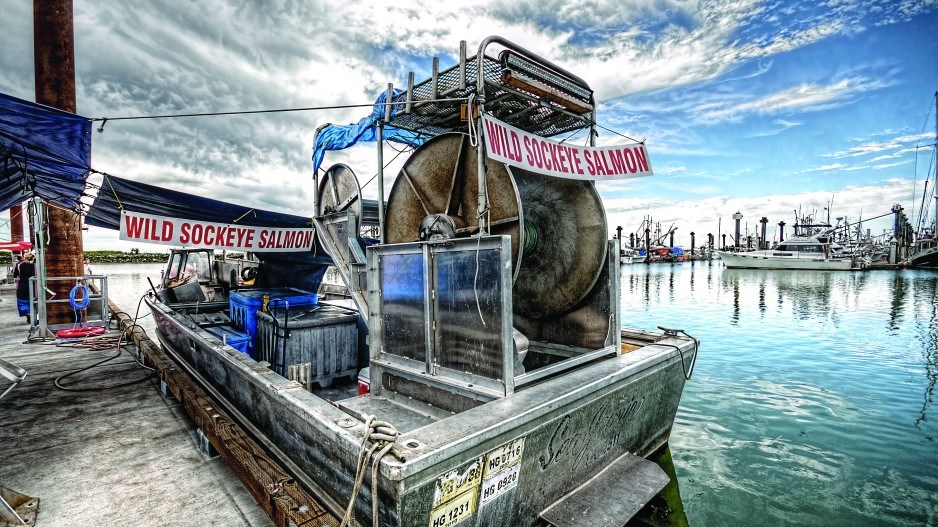Commercial fishermen in B.C. won’t be getting many – if any – opportunities to harvest sockeye salmon this year, though they may be able to at least net some pink salmon.
This year’s Fraser River sockeye return is expected to be low, based on historical patterns, and the early signs are that they are coming in even lower than forecast.
Nass and Skeena River sockeye aren’t doing any better. The only runs that seem to be doing relatively well are Somass River sockeye and Central Coast chum salmon.
“Somass is doing much better than they thought it was going to do,” said Joy Thorkelson, northern representative for the United Fishermen and Allied Workers’ Union-Unifor.
No commercial opening had been expected for Somass sockeye, but returns were strong enough to allow for a small opening for seine and gillnet fisheries.
Mike Emes, a Vancouver-based commercial fisherman who holds a licence to fish the Nass and Skeena areas, said he took a few Nass River sockeye this year, but he doesn’t expect anything from the Skeena.
“We’re not going to take one salmon out of there,” said the 72-year-old fisherman, who would gladly retire if he could sell his boat and licence. “We may have our expenses covered, but that is all.
“For some of us old-timers it’s not too devastating, but the younger guys, man, do I feel sorry for them. My boat and licence is for sale and no one’s even talking to me about buying it.”
The only positive note for those few fishermen who get some limited openings is that salmon prices are higher this year.
“Prices are better, so the impacts aren’t as great as if the prices had been poor,” Thorkelson said.
With just a few exceptions, salmon returns in general are forecast to be dismal this year, though next year’s returns are expected to be much better.
“Coast-wide, all the runs are poor, except maybe for the chums in the Central Coast, which has been a bit of a bright spot,” Thorkelson said.
Sandra Davies, North Coast salmon section head for Fisheries and Oceans Canada, said the pre-season forecast for the Nass River sockeye was 454,000, and as of last week, the in-season forecast was about half that – 234,000.
Skeena River sockeye, meanwhile, appear to be coming in on target, but that target is too low to allow a commercial fishery. The Skeena needs a return of about one million before it can open for commercial fishing, and the in-season forecast as of last week was 558,000.
As for the bread-and-butter fishery – Fraser River sockeye – things are not looking good this year.
Since the mid-1990s, Fraser River sockeye have returned to a historical cycle in which there is one large run every four years. In 2010, 28 million Fraser River sockeye returned, followed by 19 million in 2014. If the pattern holds, next year should be a relatively abundant year.
Last year’s Fraser River sockeye returns were the lowest in about a century: just 855,000.
The pre-season forecast for this year’s Fraser River sockeye returns was 4.4 million, and the early signs are that it could come in much lower than that.
“So far, things are tracking below expectations,” said Mike Lapointe, chief biologist for the Pacific Salmon Commission.
The early Stuart run – the first one to come back each season to the Fraser River – has been about half the expected run size of 99,000. Even if four million sockeye were to return, it would not be enough fish to allow for much of a commercial fishery.
Fisheries managers have set escapement targets of 1.9 million. After that, they must allocate 1.1 million sockeye to First Nations for food, social and ceremonial purposes, and U.S. fishermen get an allocation of 300,000. The combined return of 3.3 million fish is the minimum necessary before fisheries managers can approve a commercial harvest.
This year is a pink salmon year for the Fraser River. The forecast for Fraser River pink returns is about 8.7 million, so commercial fishermen should be able to at least catch pink salmon this year, although they are a much lower-valued fish.
The sockeye now returning to B.C. would have migrated to sea two years ago, when a region of warm water had developed in the north Pacific Ocean. It is speculated that the warmer water may have had an effect on the food web, reducing ocean survival rates.




